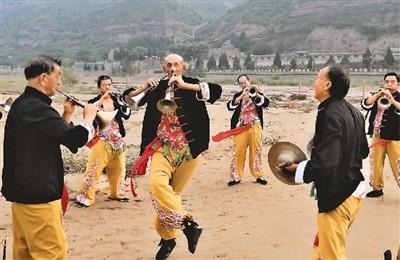Reporters from both sides of the strait visit Hukou of the Yellow River: It's so spectacular!
There are two Hukou towns on both sides of the Yellow River, one is located in Yichuan County, Yan'an City, Shaanxi Province on the west bank of the Yellow River, and the other is located in Ji County, Linfen City, Shanxi Province on the east bank. On August 18, the Yellow River, a media person from both sides of the strait, came to Hukou Town, Jixian County. The Yellow River showed its inappropriate strength and courage. The curtain and roar rushed away, leaving shock and praise!
"It's so spectacular!" said Peng Houlin, a Taiwanese reporter. He thought the Yellow River was a simple, slow-flowing river, but he didn't expect to have such an earth-shattering side. He was also attracted by the surging sound of suona by the waterfall, and surrounded the country artists who played suona to make recordings and videos. Between the mountains and rivers, suona and suona players fly freely together. In the high-pitched suona and the noise of gongs and drums, the artists sway and flash, and compete with each other. One of the artists put two suonas in his nose, and his partners occasionally flashed a gap to show his solo.
Reporters from both sides of the strait were not satisfied with watching the excitement, so they invited Yang Jisheng, the curator of Jixian Cultural Center, to be interviewed by the Yellow River to explore the way of suona in Jixian County. I heard that there was a Taiwanese reporter. Director Yang said: "We have performed suona in Jixian County in Taiwan." Director Yang introduced that the way of playing the nose is called "nosing onions", and three suonas are called "mouth spitting lotus". These are the unique skills taught by the artists of Jixian County by word of mouth. Jixian suona has always been a means of making a living for artists. There are class clubs that specialize in "white things", and there are also class clubs that specialize in "red things". Most of the people who play "white things" are mainly ancient songs, and those who play "red things" are mainly to show their skills and play cheerful songs. Jixian suona originated from Shi Xian, a scholar of Wenyuan Pavilion in Ming Dynasty. After he was assigned to Jizhou (now Jixian), he grafted the elements of court music into folk suona playing, and cultivated a group of famous artists in the village. Artists have been passed down from generation to generation. Jixian Suona is an intangible cultural heritage in Shanxi Province, and it is also an indispensable "element" for local weddings, funerals, and marriages. It is a living "heritage" that still accompanies current life.
Director Yang said regretfully: "It's a pity that you don't have time to listen to our ancestors' ancestral drum music, which is another provincial intangible cultural heritage of ours. Spectrum." Director Yang's introduction is full of emotion, not a simple description of information, and it can be seen that he loves his work. He asked the reporter if he had heard the famous Huayin old tune, and said, "Our Jixian's 'moving scrolls' is not inferior." Director Yang introduced that "moving scrolls" was produced near Hukou Waterfall, and it was sung by one person. , The rap art of everyone's accompaniment, accompanied by suona, erhu, cymbal, flute, bangzi, farm implements, etc. "Moving Volumes" is centered on Hukou Town and has been widely performed in Ji County. "It's a pity that young people are not willing to learn much, and now it is on the verge of being lost. We are working hard to organize it so that people today can see her charm."

The charm of Jixian lies in Hukou, in fact, it is also in these folk arts, but it is a pity that people come and go in a hurry because of Hukou, and even only know Hukou but not Jixian. Historically, Jixian County was not only famous for its waterfalls, but also in Ming and Qing Dynasties, futures ships docked above Hukou, which was the distribution center for land and water wharves and cargo transactions. Jia Shiqian of the Qing Dynasty recounted: Passenger ships are clustered together like fish, and there are many shops, like geese flying endlessly. The east-west main road, the north-south thoroughfare, the spring and autumn seasons, the flood and drought wharfs... Because of this, art can grow and grow, meeting us today and conveying the cultural heritage of Jixian County. Director Yang introduced that there are still dozens of cave dwellings in the Ming and Qing Dynasties at the wharf.
At the end of the interview, Taiwanese self-media person "Wan Wan uncle" was still chasing after Director Yang, who was leaving. This interview allowed reporters from both sides of the strait to discover the doorway of Jixian County: Jixian County is Jixian County with Hukou Waterfall, and Jixian County with rich cultural history!
 渝公网安备 50010702504639号
渝公网安备 50010702504639号